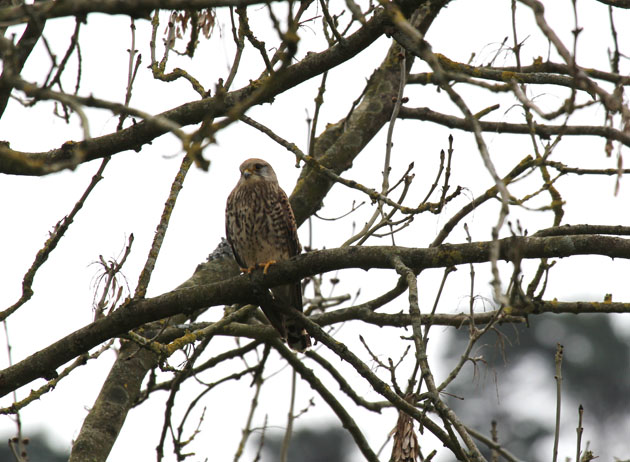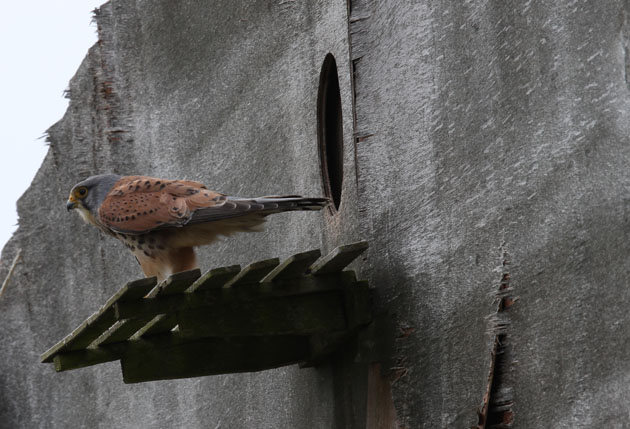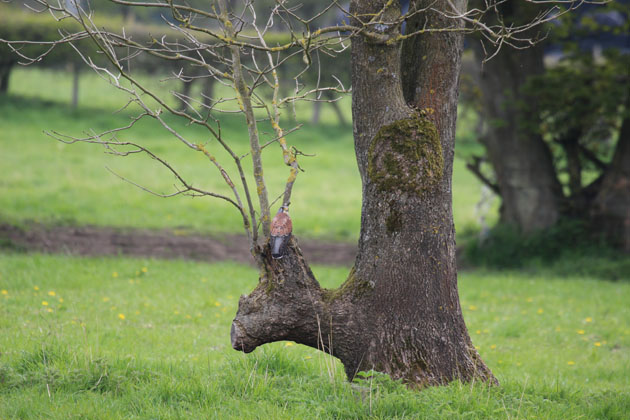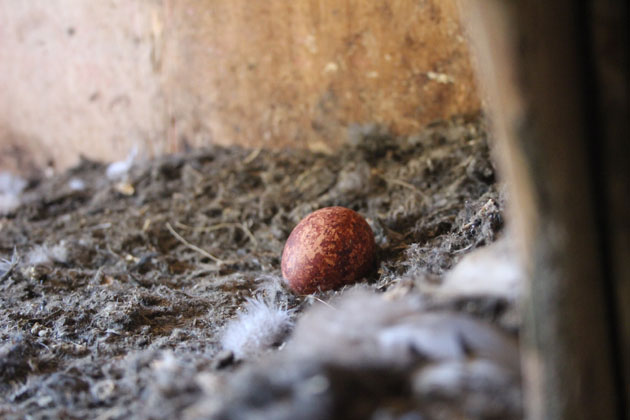Kestrel company

The female Kestrel at her favourite perch waiting for a meal
When Kestrels are around you jolly well know about it. They’re noisy birds. I saw one on my way to the workshop in early March, further down the lane and was pleased, having not seen them here before. By late March they were close-by, sitting on fence posts, and obviously checking me out.
At the time pigeons were starting to build a nest in the Barn Owl Box, although my Barn Owl was about, I hadn’t seen a pair, and certainly no visits to their box. One morning I found pigeon feathers, lots, around the nestbox and it was clear that the Kestrels had taken over.
The female bird had a favourite perch, in an Ash Tree 20 metres or so from the box – the male brought food to her here and it was where, usually, mating took place, all signalled by excited and loud calling from both birds.

The male Kestrel calling to the female from the nestbox
As they are about hunting and active during the day you get to see a lot of their behavour. I was surprised just how vocal they were, and began to recognise what certain calls meant. They’re fast birds too – a blink can see them two fields away, many times I was surprised by the male flying in low and flat and keen. Perhaps it is because I’m more used to the Barn Owls, with their soft, silent and secretive style.
The breeding season for Kestrels starts with pairing and courtship, and then the male begins to bring food to his female – when she has gained sufficient weight it triggers egg laying. During this time she becomes much less active, spending most of her time at a perch close to the nesting site. This seemed true with my pair. The male would fly in, initially visiting the nest box with food and calling loudly (as if calling the female to him). Eventually he came out of the nest box (she seemed reluctant to go in) and took the food to her at her favourite perch. These feeds came like clockwork, usually five times each day. The evening feed took a slightly different pattern in that the male flew low, then landed and ran on the ground and began tearing with his beak. At first I thought he must have caught prey and landed with it, but he went to the same place each time and I eventually I realised he had cached food there, and was either putting something in the ‘larder’ or taking out.

The male Kestrel at his cache site
Meals consisted of worms, voles, beetles, lizards and slow-worms, mostly the latter. Prey was regularly brought in live.
At one of these feeding times, with both birds busy with their rituals, I climbed up and had a look in the nestbox and found a Kestrel egg. It must have been laid overnight as I hadn’t seen the female visit the box – it was always the male who spent time there. Usually Kestrels will lay an egg, the first of a clutch of between 3 – 6 eggs, and subsequent eggs come at two day intervals and incubation generally starts after the third egg is laid. I wrote in my diary the ‘expected’ dates for eggs and sitting and watched and waited. Although the birds continued with feeds, a second egg did not materialise and some ten days later I noticed that they were not around so much. The noise was less. Then about a week later, no birds at all. I suddenly missed their presence.

Kestrel egg in the nestbox
I’m not sure why they left – did they decide I was a bit too close for comfort, or did the Barn Owl eventually say ‘get out of my box’. I saw a number of times both Kestrels mob (attack) the Barn Owl, once bringing it to the ground.
When the Kestrels first arrived I hurredly put up a Kestrel nest box, which they chose to ignore (but it was welcomed and made comfortable by a Pied Wagtail!). I wonder if they’ll come back and explore it next year, I placed it a bit further away from the workshop as I don’t think they usually favour sites inhabited by humans.
Over the last couple of evenings I’ve seen my Barn Owl fly into the box – just seems to be padding about in there and preening.

2 Comments
a cardinal built a nest over at the shop in the jasmine that grows up one of the support poles for the overhang and laid 3 eggs. It’s been weeks since either of us have spotted either bird and the three little eggs are still in the nest, obviously abandoned. so I wonder what happened as well.
Our wildlife friends pose so many questions don’t they, as we try to understand their lives – and their instincts so powerful – I’m left guessing and wondering most of the time.